Justice League #1 (DC Comics, $3.99)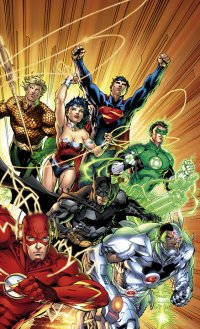
By Devon Sanders
…and so it begins.
The rebooting of The DC Universe as we knew it ends and begins in one week’s time with this week’s Justice League #1.
Let’s get down to the nuts and bolts of this; is it any good? Yes, I believe it is. Is it as bad as you may think it is? Yes, if you wish it to be so. And that just may be the brilliance of Justice League #1. It’s artist Jim Lee, arguably the most famous artist going and writer Geoff Johns, top-selling architect of The DC Universe. No stronger comics no-brainer will you find to sell a comic and they just happened to bring The Justice League along for the ride.
Set five years in the past, a plan of universal import is set to hatch and The Batman is all over it. A foot race across rooftops ensues as Batman pursues someone (or is it some “thing”) otherworldly. When all seem at their worse, enter Hal Jordan to prove that things can be made worse with the dumping of a green fire truck from on high. Things explode and Green Lantern is made aware of the need that together, they may need to become something greater with the issue’s final page truly driving the point home.
Writer Geoff Johns crafts an incredibly taut story, very much driving home the epic tone he has in mind. Something big is happening because Johns has things blow up with great frequency, and if The World’s Greatest Superheroes can, literally, find themselves on the same page, legends will be born. The problem some may find here is that The Justice League on the cover isn’t here just yet. Johns takes great pains to set up what he sees as DC’s new “Trinity,” comprised of current DC Entertainment/Warner Bros. Pictures faves, Batman, Superman and Green Lantern. Wonder Woman, former Trinity mainstay is nowhere to be seen but that may be for the best. Johns is a master of team dynamic so have no doubt that each member will have a moment to shine, if issue one is any indication.
Artist Jim Lee establishes that he just may be the perfect superhero artist. Subtlety has never been Lee’s strong suit and none’s found here as it’s totally not needed. Lee’s art just feels relentless and I mean this in a very good way. John’s script never lets up and Lee proves to be the perfect artist for the job. this is a “big” issue and frankly, no one does big superhero action better than Lee.
I had my issues with Justice League #1, sure. It felt a bit rushed yet overly decompressed, a lot has to happen here and yet, when it was all said and done, all we got were hints of what will be. In Silver Age hands, the team would’ve been assembled, the day done and the cause won. Justice League #1 is a sign that a new age truly has dawned. On the strength of this issue, I find myself growing OK with that.
Rating: 




Out of a Possible 5 Stars
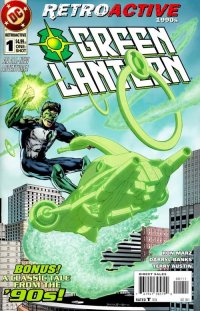 DC Retroactive 1990s Green Lantern one-shot
DC Retroactive 1990s Green Lantern one-shot
DC Retroactive 1990s Superman one-shot
DC Retroactive 1990s Justice League America one-shot
(DC Comics, $4.99)
by Graig Kent
Wikipedia defines “retro” as: “a culturally outdated or aged style, trend, mode, or fashion, from the overall postmodern past, that has since that time become functionally or superficially the norm once again”. Given the current status of DC’s superhero line, I’m not so certain they should be called “retro” so much as “nostalgic”… but then “NostalgiaActive” just doesn’t have the same ring to it, does it?
Of all the “RetroActive” books, the 1990’s Green Lantern skews the newest, as its creative team last carried the title in question from its 50th issue (wherein Kyle Rayner was introduced as the new Green Lantern, replacing a gone-mad Hal Jordan/Parallax) through to the 124th at the turn of the millennium. Because of the then-monumental events of the book, Ron Marz and Darryl Banks have solidified their place in comics history, both as destroyers of the Hal Jordan legend and creators of Kyle Rayner. The “RetroActive” story opens on a nostalgic note itself that takes it even further back than Kyle’s time, as he paints an interpretation of the famous Batman/Guy Gardner “one-punch” event that had trickled through the superhero grapevine over the years. Kyle, on monitor duty at the JLA Watchtower on the moon, naturally has his quiet and solitude disturbed as a figure breaks through Watchtower defenses,targeting directly towards him. Effigy. his wanna-be chief nemesis, is back. What progresses is a 20-page fight sequence in the ’90’s style, with lots of chatter combined with internal monologue showing the reader the face a hero gives his foes and what’s really going on underneath. It’s a fun, breezy read, with Banks’ art not only holding up to his old style but looking better than ever (Terry Austin’s feathery inks give a much different definition to Banks’ soft lines than Romeo Thangal’s harder blacks do in the back-up). Kyle’s solution for dealing with Effigy in the end seems less-than heroic, however, sending his enemy back to deep space, potentially returning him to his torturers is maybe a just punishment for the villain, but not exactly the right thing to do, let alone be disregarded so frivolously. But I quibble. The back-up feature from issue #78 provides a nice opening sequence to really explain the Kyle Rayner of the ’90’s, who he was, how green he is (no pun intended) as a superhero, but also how far he’s come, but then gets terribly bogged down in the relationship drama between Rayner and Donna Troy, which doesn’t play so well in a stand-alone setting so many years later.
Over in RetroActive 1990’s Superman, the team of Louise Simonson and Jon Bogdanov are reunited once again. They 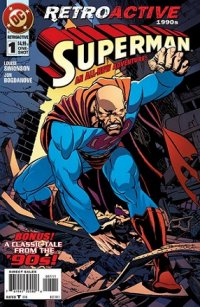 had a quite lengthy run of 80 or so issues on the Superman: Man of Steel title that launched in 1991, during which time they contributed to the “Death of Superman” storyline and created John Henry Irons, aka Steel, during the “Reign of the Supermen”. It seemed, at the time, that they were overshadowed by their line-mates, specifically Dan Jurgens, whose interests skewed towards grand-design plotting, while Simonson and Bogdanov’s work tended to be smaller-scale, more single-issue or small-arc oriented, which has served them well in readability in the long run. As witnessed here in both the main and back-up features, the pair were very focused on telling fun, entertaining, action-packed stories, that were rather free-wheeling in where they would go (delving into mad science, vampires, time travel, even ground level human interest stories). But what their run featured as an almost specialty, tailored particularly to Bogdanov’s style, were monsters, monsters, monsters. In one of the best main feature/back-up feature pairings, the retro and the back-up stories are connected by a monster, a giant toxin excreting worm that Superman had dealt with once before, only this one’s even more potent that it affects him. Simonson’s script features the Cadmus crew as well as the Daily Planet setting, not to mention Clark’s ridiculous post-resurrection ponytail (though the cover gives away what happens to that). It’s a superbly enjoyable story with some wonderful work from Bogdanov’s, whose idiosyncratic style has become a lot more refined in the intervening years, with tighter, heavier lines and more detail. I haven’t seen much of his work in the past 15 years, but I want to see more.
had a quite lengthy run of 80 or so issues on the Superman: Man of Steel title that launched in 1991, during which time they contributed to the “Death of Superman” storyline and created John Henry Irons, aka Steel, during the “Reign of the Supermen”. It seemed, at the time, that they were overshadowed by their line-mates, specifically Dan Jurgens, whose interests skewed towards grand-design plotting, while Simonson and Bogdanov’s work tended to be smaller-scale, more single-issue or small-arc oriented, which has served them well in readability in the long run. As witnessed here in both the main and back-up features, the pair were very focused on telling fun, entertaining, action-packed stories, that were rather free-wheeling in where they would go (delving into mad science, vampires, time travel, even ground level human interest stories). But what their run featured as an almost specialty, tailored particularly to Bogdanov’s style, were monsters, monsters, monsters. In one of the best main feature/back-up feature pairings, the retro and the back-up stories are connected by a monster, a giant toxin excreting worm that Superman had dealt with once before, only this one’s even more potent that it affects him. Simonson’s script features the Cadmus crew as well as the Daily Planet setting, not to mention Clark’s ridiculous post-resurrection ponytail (though the cover gives away what happens to that). It’s a superbly enjoyable story with some wonderful work from Bogdanov’s, whose idiosyncratic style has become a lot more refined in the intervening years, with tighter, heavier lines and more detail. I haven’t seen much of his work in the past 15 years, but I want to see more.
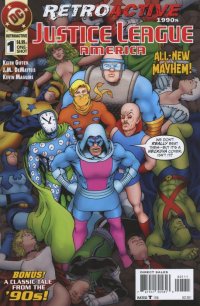 When it comes to the Giffen/DeMatteis-era of the Justice League, I don’t so much as think of “retro” or even “nostalgia” so much as “beloved”. Their run on the series was a defining one for many, myself included, and perhaps it’s through rose-colored glasses through which I view it, but it’s still one of the most tremendous comic book series ever made. Keith Giffen, J.M. Dematteis and Kevin Maguire created a series that has not only endured the test of time but staved off over-saturation by producing a singular work that, quite frankly, has only ever been replicated by the very same creative team. The Justice League was a superhero comedy, yes, but it also was about building a family, and in that there was a tremendous amount of heart alongside the humor and tragedy. The RetroActive story captures that in the tale of the Injustice League, looking to turn over a new leaf, or at least not get beaten up so much, establishing this rag-tag group of semi-moronic villains as a family all their own. When the Justice League didn’t face an international/pan-galactic threat, then chances are they were cleaning up a mess of their own making. In this issue, they’re teaming up with the Injustice League to clean up their little mess, in the form of a 30-foot para-demonized Big Sir. It’s a vintage Giffen/DeMatteis script, at times laugh-out-loud funny but with more tender moments as well that feels like it could be inserted into the original run, more so than any other Retroactive book has achieved. As usual, Kevin Maguire’s art steals the show. The man, 25 years after Justice League #1 debuted, is still unrivaled in facial expressions and character gesticulations. not to forget his comedic timing. The term “genius” may get bandied about too loosely, but in Maguire’s case it’s earned. He’s every bit as good as he ever was, perhaps even better. The back-up feature here is an odd choice, given that it’s the final issue of the Giffen/DeMatteis run, then again, Maguire had long since left the book before it found its way into the 1990’s so I guess this was all they had to choose from if they wanted a 90’s work from the key trio. With the new DC dawning this week, this may be the last we see of the “Bwa Ha Ha” Justice League, but it’s not a bad bit to go out with.
When it comes to the Giffen/DeMatteis-era of the Justice League, I don’t so much as think of “retro” or even “nostalgia” so much as “beloved”. Their run on the series was a defining one for many, myself included, and perhaps it’s through rose-colored glasses through which I view it, but it’s still one of the most tremendous comic book series ever made. Keith Giffen, J.M. Dematteis and Kevin Maguire created a series that has not only endured the test of time but staved off over-saturation by producing a singular work that, quite frankly, has only ever been replicated by the very same creative team. The Justice League was a superhero comedy, yes, but it also was about building a family, and in that there was a tremendous amount of heart alongside the humor and tragedy. The RetroActive story captures that in the tale of the Injustice League, looking to turn over a new leaf, or at least not get beaten up so much, establishing this rag-tag group of semi-moronic villains as a family all their own. When the Justice League didn’t face an international/pan-galactic threat, then chances are they were cleaning up a mess of their own making. In this issue, they’re teaming up with the Injustice League to clean up their little mess, in the form of a 30-foot para-demonized Big Sir. It’s a vintage Giffen/DeMatteis script, at times laugh-out-loud funny but with more tender moments as well that feels like it could be inserted into the original run, more so than any other Retroactive book has achieved. As usual, Kevin Maguire’s art steals the show. The man, 25 years after Justice League #1 debuted, is still unrivaled in facial expressions and character gesticulations. not to forget his comedic timing. The term “genius” may get bandied about too loosely, but in Maguire’s case it’s earned. He’s every bit as good as he ever was, perhaps even better. The back-up feature here is an odd choice, given that it’s the final issue of the Giffen/DeMatteis run, then again, Maguire had long since left the book before it found its way into the 1990’s so I guess this was all they had to choose from if they wanted a 90’s work from the key trio. With the new DC dawning this week, this may be the last we see of the “Bwa Ha Ha” Justice League, but it’s not a bad bit to go out with.
DC RetroActive 1990s Green Lantern one-shot -Rating: 




Out of a Possible 5 Stars
DC RetroActive 1990s Superman one-shot – Rating: 




Out of a Possible 5 Stars
DC RetroActive 1990s Justice League America one-shot – Rating:





Out of a Possible 5 Stars
The Ultimates #1 (Ultimate Comics/Marvel, 3.99)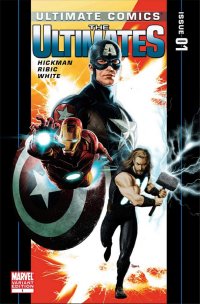
By Adam Prosser
When is fidelity to the original a bad thing? Well, when the original isn’t very good, obviously. Even when a real talent is brought on board to clean up a messy concept created by someone else—as has happened repeatedly throughout the history of comics—you tend to respect the later talent for trying to get to the root of what the original was trying to do. But sometimes that original writer just becomes an albatross around the neck of anyone trying to fix it.
I really didn’t like Mark Millar and Brian Hitch’s The Ultimates. In fact, despite a handful of superficially good ideas, I thought it was a pretty good example of everything that’s wrong with modern superhero comics. From the decompression, to the attempt to turn this story about a thunder god and a guy who controls ants teaming up with the Incredible Hulk into a “realistic” spy thriller, to the pointless ultraviolence, to the characterizations of pretty much everyone as a bunch of self-absorbed, hateful sociopaths (sociopaths who spout sub-sub-Tarantino pop culture referencing dialogue, to boot), it was a comic that embodied the idea that the superhero genre is now completely ashamed of its roots. Never mind that superheroes, in the past, used to sell millions of copies by appealing to kids with a message of idealism, imagination and fun; it’s now apparently more important to be cool and edgy in the eyes of the ever-dwindling fanbase who want their superheroes taken very, very seriously. This still might have worked as disposable entertainment if Millar’s writing wasn’t so utterly obnoxious—continually trying to make a case for itself as a movie instead of a comic, relying on pointless shock value (the Hulk is a cannibal! Quicksilver and Scarlet Witch are having an incestuous affair!), and packing it with self-referencing scenes like having Samuel L. Jackson as Nick Fury talking about how Samuel L. Jackson should play him in the movie. (And if anyone out there was able to resist throwing the comic across the room at that point, let me know. I was reading a borrowed copy, so I was able to resist out of politeness, but just barely.)
Jeph Loeb has been tarred and feathered for “ruining” the Ultimates franchise, but frankly, I’m not sure he ruined it so much as followed it to its logical conclusion.
Now here we are with Jonathan Hickman, who’s taken the reins of the Ultimates universe of late, and is now writing this relaunched key book. To say Hickman is a better writer than Millar is a bit like saying the planet Jupiter is slightly larger than my thumb, but he also seems to feel the need, in this first issue, to pay homage to what’s come before. That’s commendable in the abstract, but it means that Millar’s vision still taints what is otherwise a fine superhero book.
The story is mostly told from the point of view of Nick Fury in the Triskelion’s command center, monitoring the various global situations that might require superhero attention. A naval clash in South America has Tony Stark intervening, the Norse gods are causing tension in Europe, that kind of thing. While it’s a little too exposition-heavy for my liking (a recurring problem with Hickman) it does a good job of conveying the intensity and crushing pressure that a superhero task force would have to deal with, and makes those “heroes sit around yakking about pop culture” scenes in the original volumes all the more unbearable. Anyway, things go haywire when all the heroes on assignment are suddenly attacked, simultaneously, by an unknown enemy that seems to be very, very powerful indeed, leaving the Triskelion blind and cut off.
There’s a lot to like here, particularly the Thor sequences, which play out without dialogue (since Fury doesn’t have a sound hook-up) and make a nice antidote for the endless technobabble of the rest of the issue. As I said, the problem I have with this book is that I hate Millar’s characterizations, to which Hickman remains faithful, with Tony Stark in particular being a pretty big tool. However, by focusing on Nick Fury as a serious man doing a hard job, he does manage to make him more likeable, a trend I hope will continue.
In fact, there are signs, starting with the monologue on the first page, that Hickman’s going to try and deal with the fundamental amorality and unpleasantness of Millar’s vision. I don’t think it’s a coincidence that, as the story opens, Captain America has gone missing, and we then get a plot in which the Avenger’s arrogance puts them in a tight spot. It seems like Hickman’s going to take the hard road of redeeming these characters from the amoral dunderheads Millar made them out to be. This means that we have to start from the same place Millar (and Loeb, I’m assuming) left off, which makes for a less than appealing comic—but I’m expecting great things further down the road. With any luck, Hickman can put the “hero” back in “superhero”.
Rating: 




Out of a Possible 5 Stars
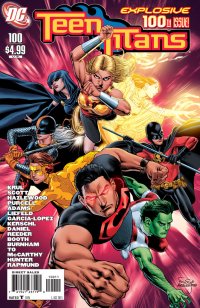 Teen Titans #100 (DC Comics, $4.99)
Teen Titans #100 (DC Comics, $4.99)
by Graig Kent
I’ve lamented the end a few books here over the past few weeks, as DC winds down much of its history in favor of a largely brand new one. With about three months to let it sink in, I’ve made my peace with it, and have actually learned to even get a little bit excited by it, but as some of my favorite titles come to a close, I can’t help but feel pangs of regret. Some titles or characters, like Justice League or Flash or Wonder Woman or Superman have changed so frequently over the years that new interpretations of the characters or teams is almost status quo. There’s really not a lot of reason to lament them if you’ve been around long enough. But books like Secret Six and Batgirl were rather singular in nature, unique titles driven by a specific creator, featuring specific characters, lightning-in-a-bottle-type stuff that just won’t come back again.
The Teen Titans is one of those teams, featuring those characters who constantly seem to be in flux. The title was guided so long (perhaps too long) by Marv Wolfman throughout the ’80’s and ’90’s that the type of storytelling that the book became known for, as well as the type of characters that comprised the team were really the product of that singular vision, lighting-in-a-bottle type thing. In the years since, on relaunch after another the Teen Titans never looked or felt much like the *legendary* Teen Titans, the title that used to give the X-Men a run for their money. Geoff Johns got about as close as one could, reinventing the team with the Young Justice crew, and going back to the idea of a team of sidekicks. Even still, it rarely felt like the Teen Titans because the characters didn’t quite read like teenagers.
Less than a year ago J.T. Krul took hold of the team, reunited the “Young Justice” members and added other dollops of recent and not-so-recent casts, and proceeded to capture the lightning that had long been missing. The “teens” were back, the melodrama returned, there was a playfulness between some characters, flirting between others and definite friction between more. Krul’s only major storyline in his short run led the Titans on an international adventure where they met a superpowered young Indian girl named Solstice, during which they were sucked into an alternate dimension where old gods were scheming to find relevance once again through global domination. The characters and the action were unique but the set-up was familiar, it was a Teen Titans plot through and through.
Krul’s 13 issues were a return to form for the series, a form that had been missing from the title for decades. Thanks to a bi-weekly shipping schedule the past two months, Krul was allowed to finish the storylines he was working on and provide the book and team a conclusion worthy of it. In this 100th issue, the current team squares off against their own rogues gallery led by Superboy-Prime, yes, back again and petulant as ever. But the Titans call in the reserves and it’s a veritable who’s who of the Titans of yore. It’s a lovely send off, sad though it is.
Krul was partnered with Nicola Scott, whose natural, exquisitely rendered environments are populated by characters who look less like comic book characters and more like people, teenagers to be precise. She’s perhaps one of the most undercelebrated artist in the business, but her work is gorgeous.
The book ends with an 8 page pin-up gallery by some of the artists who have worked on the title or characters over the years (Karl Kershl, Tony Daniel, Jose Luis Garcia-Lopez), but not all, instead filling out the ranks with forthcoming Titans illustrator Brett Booth, Amy Reeder, Chris Burnham, Marcus To and, for some reason Rob Liefeld (why, people, why?). It would have been nice if more Titans illustrators of old, like Mike McKone, George Perez, Tom Grummett and Dan Jurgens paid their respects.
By the looks of the new Teen Titans book in the new DCU, the lightning has gone out of the bottle again (yes, I am pre-judging). I could be surprised, but when a broken thing is finally fixed, it seems not such a good idea to go ahead an break it again so soon.
Rating: 




Out of a Possible 5 Stars
Kevin Smith’s The Bionic Man #1 (Dynamite, $3.99)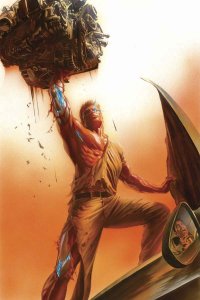
by Graig Kent
Dynamite had a modest success with adapting Kevin Smith’s treatment The Green Hornet to comics by way of the team of Phil Hester and Jonathan Lau, so they’re trying it again, taking another treatment of Smith’s that updated origin for Steve Austin and Hester and Lau extrapolating upon it. By the looks of things, Dynamite should have another modest success on their hands.
To be honest, The Six Million Dollar Man was just slightly before my time. I believe I caught a few episodes in mid-afternoon reruns as a kid but am most familiar with the character from the Six Million Dollar Man/Bionic Woman TV movies that aired in the late-’80’s and early ’90’s… and by “most familiar” I mean I don’t really recall much about it at all save for Lee Majors, Linday Wagner, the slow-motion action and the bionic sounds they make. A quick perusal of the youtubes refreshes the memory a little more, but what is most glaringly obvious is that the production is ridiculously dated and plays out almost like camp.
A quick glimpse at the Wikipedia on Steve Austin reveals that Smith has adhered rather firmly to the Austin origin story (at this point at least). Why break something that doesn’t need fixing? Or rather, break it and fix it, but don’t break the method of the breaking and don’t fix the method of the fixing. Here, as before, Austin is an ace pilot charged with showing off an experimental aircraft. Obviously things go wrong. It’s a simple origin, and the book ends on a cliffhanger of Austin’s plane going down, his ejector seat malfunctioning, and things looking pretty dire.
Hester’s script could so easily be formulaic and oversimplified, cheesy and unceremonious, instead he takes the time to establish a setting, the characters and the general world in which Steve Austin lives. I’m always impressed with Hester’s writing, he’s got a knack for pacing and characterization which goes a long way in differentiating his work from other genre books. It’s almost 10 pages before we first meet Austin, Smith’s story establishes an existing, more primitive bionic man who is obviously enacting some sort of revenge by sabotaging the bionics manufacturer and seemingly murdering everyone in the building. It’s not hard to see how this plot will interact with Austin’s story, but Hester works them together nicely through a connective, shadowy character present at Austin’s aircraft launch, and later investigating the crime scene.
Lau’s art is defined by thin lines and an Neal Adams-esque sense of feathery shading. It’s a polished look that is aided well by Lau’s terrific storytelling sensibility. He’s tasked with plenty of talking head sequences which he handles as adeptly as he does the violence and the action, technology and settings. It’s a well developed, good looking package that doesn’t reinvent the wheel, just makes it sleek and modern.
Rating: 




Out of a Possible 5 Stars
Ultimate Comics Hawkeye #1 (Marvel, $3.99) 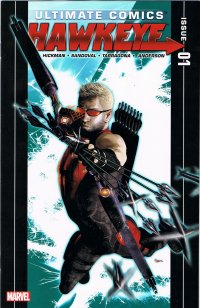
By Jeb D.
You wouldn’t normally think of Mark Millar and Jonathan Hickman as particularly similar in their approach to comic book storytelling: Millar’s the hyped-up adolescent, giggling through his sugar high as he puts his favorite characters through twists and torments that their original creators never imagined; Hickman is the meticulous, post-graduate technocrat, respectful of history, eager both to learn from it and to apply new ideas and media to it.
But what joins both writers is a link to the “what if” credo that has fueled Marvel since the days of Lee and Kirby and Ditko: if I looked out my window on a world where these impossible characters existed, what would I see? Love the original Ultimates or hate them (and see my colleague Adam’s review, above, for his take on The Ultimates old and new), Millar managed to give them a modern, lived-in feel—not the dated pop-culture references (anyone out there actually remember Freddie Prinze?), but the sense that the challenges they faced were as much personal, social and political as super-villainous. The series lost that direction, and most of its strength, following Millar’s departure, and while he made some attempts to wrench the Ultimate universe back onto its feet recently, his heart seems mostly to be with his Millarworld projects these days. Fortunately, Hickman’s here to pick up the slack. His first issue of The Ultimates brought his heroes up against a series of geopolitical (and godly-political, I guess you’d say) challenges, before blowing them up. This comic starts to pick up the pieces.
Hawkeye’s been sent to investigate a super-being threat emanating from the SEAR (Southeast Asian Republic)… which, despite its capital being Bangkok, is clearly the Ultimate U’s version of mainland China, and this is a most intriguing choice on Hickman’s (and Marvel’s) part. The fact is, the need to market American pop culture to emerging world markets means that the “bad guys” in comics, movies, what have you, tend to be clearly American or white European; and, as we saw in the Captain America film, even repressive governments are never at fault: it’s always some spinoff or splinter group. But we’re living in a high-tech world where the Chinese government has already sanctioned and supported cyber-warfare: in a world where super-soldier technology existed, wouldn’t it make sense for such an authoritarian regime to employ them in similar attempts to destabilize its rivals? In fact, the nefarious plan that Hickman has drawn up here is elegantly simple, with a nod or two to some vaguely plausible science, and with implications that could make for some mighty interesting times in the Ultimate U (though I won’t be surprised if he draws some flak for creating a modern “yellow peril” storyline).
If there’s a problem with this issue, though, it’s that laying out the plan is pretty much as far as we get. While there’s a couple of good action scenes, they feel like curtain-raisers, as it’s only at the final panel of the book that Clint Barton really sets off on his assignment. Artist Rafa Sandoval’s style always seems to be a sort of middle ground between the detail of Bryan Hitch and the kineticism of Stuart Immonen: not bad, but lacking the distinctive brilliance of either; certainly nothing of the caliber of Esad Ribic’s work on The Ultimates.
If you were intrigued by Hickman’s start to The Ultimates, and you’re ready to settle in with the larger story he’s telling, then you’ll find this an intriguing chapter. But you’re not going to find it a knock-off-your-socks standalone.
Rating: 




Out of a Possible 5 Stars
The Rinse #1 (BOOM! Studio, $1.00) 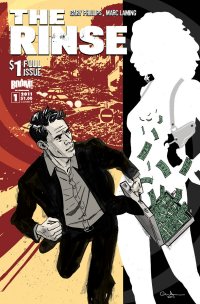
By Jeb D.
First of all, note the cover price: you’d sort of think this comic would have to be pretty bad not to at least take a chance on it for a buck. Fortunately, as it happens, I’d give this book a recommendation even if were offered at full price.
The “rinse” in question here has to do with money laundering: our protagonist is Jeff Sinclair, an expert in this arcane, sophisticated form of crime, and his clients tend to be fairly safe and sedate dope farmers. There’s an entertaining “Burn Notice” feel to the book’s introductory section, as Jeff takes us through the daily ins and outs of his business.
But, hey, this is a crime comic, and in crime comics, even the most capable professional finds himself getting in over his head—sometimes it’s a dame, sometimes it’s a score too big to pass up. In this case, the deep end is represented by a Vegas casino accountant who’s got 25 million embezzled dollars that need “rinsing,” As with a lot of crime/noir stories, the reader’s first impulse is to wonder how the hell Jeff can be so stupid (the new “client” isn’t even subtle about the mob connection to the stolen loot), even for a multi-million dollar payday, but writer Gary Phillips moves the story along at a cracking pace, so that we’re sufficiently intrigued to go along with it. He also throws in some fisticuffs, death by BART, a sexy Fed (an IRS agent, which is kind of a nice twist), and a few other complications, insuring that Jeff’s story will need a lot of (presumably violent) sorting out before it’s through.
Artist Marc Laming’s style (abetted by colorist Darrin Moore) has a nice eye for urban detail and character consistency. The few bits of action are handled well enough, but if story’s resolution involves your usual action set pieces (shootouts, car chases, etc.), it’ll be interesting to see if he can deliver.
More and more comic artists and writers seem to be enjoying the use of San Francisco as a setting these days, and not even my familiarity with the place (I work in the heart of what’s called the Financial District) keeps that from being a welcome change of pace when the creative team takes the time to exploit something beyond the obvious tourist visuals: this does feel very much like the day-to-day City by the Bay.
At full price, this one would be recommended; I’m giving it an extra “star” for being a bargain.
Rating: 




Out of a Possible 5 Stars